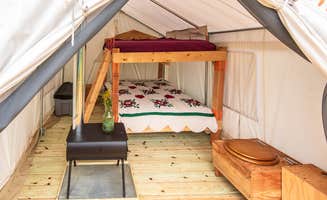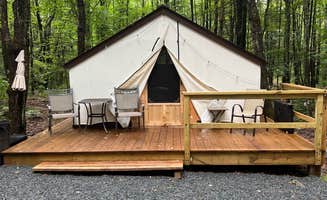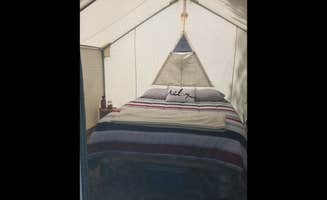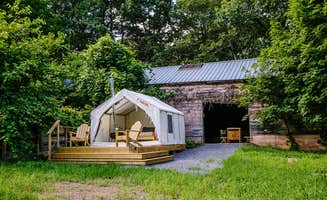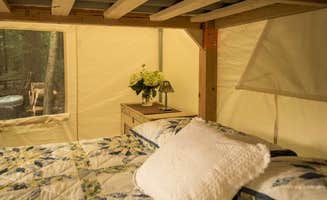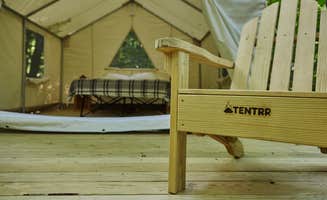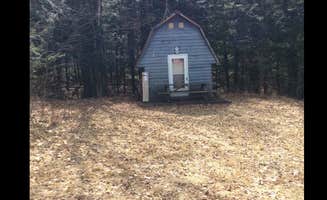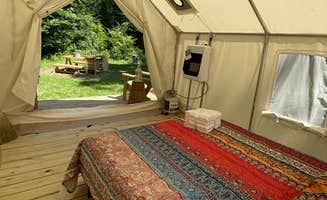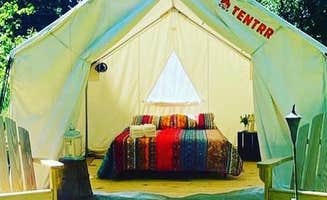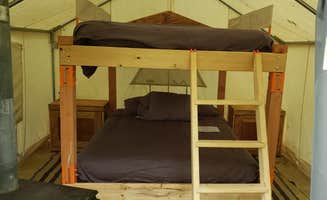The Catskill Mountains surrounding Hunter, New York rise to elevations around 4,000 feet, creating varied camping microclimates throughout the seasons. Summer temperatures typically range from 55-80°F with higher humidity, while spring and fall camping often requires additional layers for temperature drops after sunset. Many campgrounds in this region sit alongside creeks or small waterways, providing natural water features but also potential for mud during rainy periods.
What to Do
Hiking Vromans Nose: Located near Max V. Shaul State Park Campground, this moderate trail offers distinct rock formations and valley views. "There's no pond/lake here but there's several waterfalls nearby and vromans nose," notes Brian H. in his review of Max V. Shaul.
Swimming at Lake Taghkanic: The lake provides a clean swimming area with dedicated beach. "The lake is gorgeous and there are plenty of nearby hikes for exploring. Wish I would have brought my fishing pole," shares Rosie R. about Lake Taghkanic State Park, which also offers boat rentals for water recreation.
Farm animal visits: Some campgrounds incorporate small farm elements. At Brookside Campground, David R. mentions "Small farm right next to our site, goats, cow chickens, ducks, geese," creating unique experiences for animal lovers.
Stargazing opportunities: Clear Catskill nights provide excellent celestial viewing. "Late night, stargazing over the lake is a great pastime, because the water is calm and the light pollution is low," explains Seth K. about Lake Taghkanic State Park.
What Campers Like
Spacious, well-separated sites: Many Catskill campgrounds offer better site spacing than typical commercial campgrounds. At Max V. Shaul, Holly R. describes "only 30 sites here, which are large, flat and sited well apart from each other."
Natural water features: Creeks and streams enhance many camping experiences. At Thousand Trails Rondout Valley, Scott notes that "a babbling brook was 30 feet behind us. Great spot for morning coffee."
Clean, updated facilities: Bathroom quality varies widely but several campgrounds stand out. At Max V. Shaul State Park Campground, professorthedog P. reported the "cleanest facilities ever! Good adjustable campfire cooking rack."
Platform tent sites: These raised wooden platforms provide additional comfort during wet weather. "The platforms kept us off the ground and were helpful in setting up appropriate tarp protection!" explains Rosie R. about Lake Taghkanic during rainy conditions.
What You Should Know
Full-timer vs. recreational campgrounds: Some campgrounds primarily serve seasonal residents rather than short-stay campers. Chelsea B. warns about Brookside Campground: "When we arrived we were surprised that this was mostly a trailer park. Call me picky, but I really prefer not to camp in an area where folks are living full time."
Water quality concerns: Not all campgrounds maintain consistent water standards. Peter S. noted issues at Nickerson Park: "The water smelled like raw sewage, loaded with sediment and very discolored. Little to no pressure and a couple times no water at all."
Weather preparedness: Rain impacts vary significantly by campground location and drainage. At Nickerson Park Campground, David S. observed that "During the heavy rains water flowed down the roads ways due to the clay based soil and looked like it pooled up in places near the tent areas."
Off-season availability: Several campgrounds close completely outside peak seasons. Lake Taghkanic operates from "May 6 to October 15" while Max V. Shaul runs from "May 19 to October 10," requiring advance planning for spring or fall glamping in Hunter, New York.
Tips for Camping with Families
Activity programming: Family-oriented campgrounds offer structured events. At Jellystone Park Gardiner, Jennifer I. notes the campground "has a event just about every weekend with kid activity."
Water features for various ages: Pool designs matter for family enjoyment. Amanda S. appreciates that Jellystone has a "nice pool that is shallow so you can relax and let the little ones go in the water park section alone or they have a 3 ft pool also."
Playground proximity considerations: Evaluate site location relative to play areas. At Thousand Trails Rondout Valley, Inez W. advises that "The campground itself is pretty quiet, although there is some noise by the playground."
Alternative lodging during storms: Some glamping facilities in the Hunter area provide storm contingency options. At Brookside Campground, Michael A. shared: "We use tents and got a bad storm the owner called and let up bunk in the arcade for the night since she was worried."
Tips from RVers
Site leveling challenges: Many Catskills campgrounds feature terrain variations. At Thousand Trails Rondout Valley, Inez W. notes "my site (372 - full hookup) but they let me choose another site (435 - no sewer) and I was happy as a clam. Oh yea, the sewer connection in 372 ran uphill for me, but my pipe sits very low."
Big rig accessibility: Limited options exist for larger RVs in the Hunter region. Molly G. points out that Brookside Campground accommodates larger vehicles: "We ended up at this campground because the family we were traveling with needed to accommodate their 50 foot camper."
Seasonal site selection: RV placement affects experience quality. At Nickerson Park Campground, Taylor H. recommends visiting during quieter periods: "We stayed for two nights mid-week in June and had the entire loop to ourselves. That made the experience a 5/5, but after seeing the site layout, it seems like accessibility could be an issue with high occupancy."
Utility reliability: Services can vary even at established campgrounds. Jason E. observed at Thousand Trails Rondout Valley: "We did use the laundry room, which needed some updates, especially some lighting. It has a pretty large staircase and at night with a handful of laundry, it was a little scary navigating without lights."


